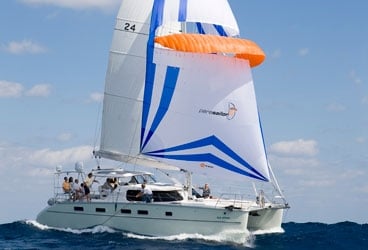
cats of age 368
When cruising multihulls were a novelty, they appeared on the world’s oceans in small numbers but in great variety. Most were one-offs or home-built to designs by Lock Crowther, Dick Newick, John Marples, Jim Brown, Derek Kelsall, and James Wharram, not to even mention the French contingent.When cruising multihulls were a novelty, they appeared on the world’s oceans in small numbers but in great variety. Most were one-offs or home-built to designs by Lock Crowther, Dick Newick, John Marples, Jim Brown, Derek Kelsall, and James Wharram, not to even mention the French contingent. All of the boats incorporated the idiosyncrasies of their designers and builders, as well as their owners, some of whom were looking for speed, some for comfort, and some for simple and cheap construction. Dick Newick is famous for saying that you can meet any two of those conditions in a boat, but not all three.
The truth in Newick’s words became evident when multihulls were fed into the great homogenizer of mass-production boatbuilding, in which manufacturing economy and onboard comfort, the latter measured in terms of accommodation volume and amenities, established which way the playing field would tilt. First to slide off into obscurity was the cruising trimaran, which, to an accountant, is a skinny monohull with two extra hulls that contribute nothing to the bottom line but create enormous headaches in the engineering department. Naturally, there are exceptions, most obviously Corsair Marine, Dragonfly, and the Telstar, among three that come to mind to prove the flaw in such a sweeping statement, but those can be reasonably said to cater to a very focused clientele.
By reverse-engineering Lloyd’s scantling rules for a wooden hull, you can quite easily come up with a way to build a fiberglass monohull so it won’t break (and that’s pretty much what Lloyd’s itself did). The same isn’t true with multihulls. A trimaran has three hulls that may all be trying to go in different directions up, down, or across several waves at the same time, creating all manner of rapidly changing torsional stresses on the structure. Catamarans are only somewhat less complex. When these craft were new on the scene, their designers established engineering criteria by trial and error, often using high-profile ocean-racing events as their laboratory. The inevitable accidents were also high profile and, while showcasing the sailors’ considerable bravado, they raised a cloud of doubt over the seaworthiness of multihulls as a class.
Other designers and builders were more discreet and used small racing cats as crash-test vehicles in a more controllable environment than the middle of the Atlantic. One such designer, Peter Wormwood, later expanded his efforts into the realm of high-performance cruising catamarans. Though not an engineer (he trusts that work to the specialists), he’s well aware of the challenges his designs present: To be fast, a boat has to be light; to be strong, it needs adequate structure.
“You just can’t get there with E-glass and polyester resin,” Wormwood says. “To get the needed strength, you simply end up too heavy.” The solution lies in exotic and expensive materials, at the very least in epoxy and carefully oriented fibers. Even then, getting the balance right is a fine art indeed, and Wormwood says that a performance cat that doesn’t develop surface stress cracks here and there is probably built too heavy.
This is an acceptable approach for the racing sailor who needs to be closer to the hairy edge than his competitor, but it’s not so cool for a retired couple on the Caribbean cruise they worked a lifetime to enjoy. Consequently, production builders tend to not worry so much about tipping toward the heavy side of the equation.
Not that “heavy” in this context means adding layers and layers of fiberglass just to be on the safe side-the cost of materials and advances in structural design techniques make that unfeasible and unnecessary. Instead, the weight of many production catamarans has more to do with the parts found between the hulls-the bridgedeck and the living quarters-and in the cruising goodies: engines, generator, climate control, and the fuel to power them all.
Heavy brings certain rewards. Just as a heavy monohull carries its crew in stately comfort and allows them to be well supplied with stores, amenities, and spare parts for every eventuality, so can a catamaran that’s designed to carry the payload. But this is the key: If a cat is down on its lines, the bridgedeck is close to the sea surface, and that can impair performance. The hulls have to have enough reserve volume that this doesn’t happen even when the boat is equipped and provisioned for the long haul. That makes cruising-cat hulls less fine and less slippery than performance hulls, but they’re still narrower than monohull hulls and, on the right points of sail, can exploit that difference to attain double-digit speeds. And the extra volume delivers living space in spades.
For many boat buyers, it’s this living space-and a disinclination to heeling-that are the clinching arguments for a catamaran: all that room and never a need to wipe up spilled coffee. Anyone getting into a cat for those reasons probably doesn’t lightly entertain the idea of flying a hull and is therefore content to occupy the corner of Newick’s triangle where comfort and moderate cost converge.
Jeremy McGeary is a CW contributing editor.








